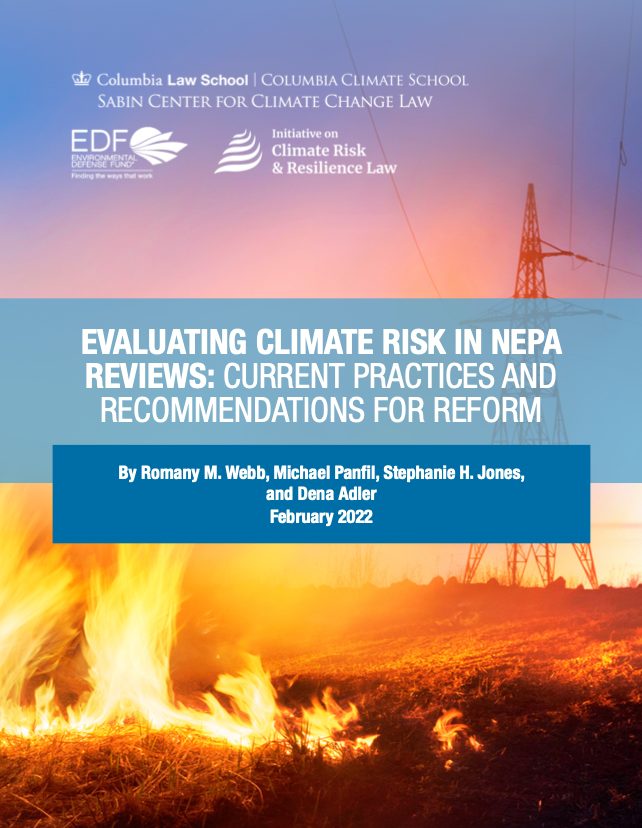By Jessica Wentz and Romany Webb
 On Thursday, December 6, the Environmental Protection Agency (EPA) published proposed revisions to its New Source Performance Standards (NSPS) for electric utility generating units (2015 NSPS). The proposal affects new, modified, and reconstructed fossil fuel-fired steam generating units, most of which use coal to generate electricity, either by burning it in boilers or using gasification technologies. Those units emit significant carbon dioxide, with EPA finding that “emissions from even a single new coal-fired [unit] may amount to millions of tons each year,” and thus have major climate impacts. Despite this, however, EPA is proposing to weaken the carbon dioxide emission standards imposed on such facilities under the 2015 NSPS. Here are four important things to know about EPA’s proposal:
On Thursday, December 6, the Environmental Protection Agency (EPA) published proposed revisions to its New Source Performance Standards (NSPS) for electric utility generating units (2015 NSPS). The proposal affects new, modified, and reconstructed fossil fuel-fired steam generating units, most of which use coal to generate electricity, either by burning it in boilers or using gasification technologies. Those units emit significant carbon dioxide, with EPA finding that “emissions from even a single new coal-fired [unit] may amount to millions of tons each year,” and thus have major climate impacts. Despite this, however, EPA is proposing to weaken the carbon dioxide emission standards imposed on such facilities under the 2015 NSPS. Here are four important things to know about EPA’s proposal:
1. EPA’s proposal would allow new generating units to emit more carbon dioxide: In the 2015 NSPS, EPA required all newly constructed fossil fuel-fired steam generating units to limit carbon dioxide emissions to 1,400 pounds per megawatt hour of gross output (lb CO2 / MWh-g), concluding that this could be achieved by using post-combustion carbon capture and sequestration (CCS) technologies to capture and store a percentage of the CO2 emissions generated (16-23% depending on the type of coal used). EPA is now proposing to revise the emission limits upwards based on its determination that the BSER should not include partial CCS (more on this below). Under the proposal, three separate limits would be established for different types of fossil fuel-fired steam generating units, as shown in the table below.
| Type of Unit | Emission Limit |
| Large fossil fuel-fired steam generating units (with heat input greater than 2,000 million British thermal units (MMBtu) per hour) | 1,900 lb CO2 / MWh-g |
| Small fossil fuel-fired steam generating units (with heat input less than or equal to 2,000 MMBtu per hour) | 2,000 lb CO2 / MWh-g |
| Coal refuse-fired sources | 2,200 lb CO2 / MWh-g |
For all three types of units, EPA is proposing to weaken the emission limits, effectively allowing individual generating units to emit more carbon dioxide (i.e., compared to if the 2015 NSPS remained in place). Nevertheless, EPA asserts that its proposal will result in “negligible changes” in total carbon dioxide emissions, at least through 2026. EPA bases this assertion on data showing that, due to the low cost of natural gas and renewable energy, few (if any) new coal generating units are likely to be built in the foreseeable future. While that is certainly true, it is possible that some new coal-fired units will still be constructed, including by operators wanting to diversify their generation fleets (e.g., as a means of hedging against future natural gas price increases). To the extent that occurs, EPA’s proposal would result in an increase in emissions, compared to if the 2015 Rule remained in place.
2. EPA has reversed course on its determination that carbon capture and storage (CCS) is an adequately demonstrated technology, despite scientific evidence to the contrary: Section 111 of the Clean Air Act instructs EPA to establish emission standards based on “the application of the best system of emission reduction [BSER] which… the Administrator determines has been adequately demonstrated.” In defining the BSER for the 2015 NSPS, EPA concluded that CCS was adequately demonstrated based on the successful application of this technology in both the industrial and power sectors. EPA also found that CCS technologies were widely available and that partial capture could be implemented at a reasonable cost. When the original NSPS was challenged in court, the Sabin Center submitted an amicus brief on behalf of leading CCS experts in support of these findings.
In this new proposal, EPA has raised questions as to whether CCS is technologically feasible based on operational challenges experienced at two key CCS projects – the SaskPower Boundary Dam project in Canada and the NRG Petra Nova project in Houston, Texas. What EPA fails to acknowledge is that even with those challenges, both projects are currently operational and capturing a significantly larger proportion of CO2 from their respective power plants than what would be required under the rule. The Petra Nova CCS facility captures approximately 90% of the CO2 emitted from the flue gas slipstream at which it is installed (approximately 33% of the total power plant emissions) and the Boundary Dam CCS facility, is also capable of capturing approximately 90% of CO2 when operating at peak performance. The chart below shows the significant emissions reductions achieved at the Petra Nova facility (note that this was a retrofit to an existing power plant so the emissions intensity with CCS is higher than it would be for a new power plant):
EPA is also proposing to rescind its prior determination that the cost of partial CCS was reasonable, which was based on findings that: (i) the levelized costs of implementing partial CCS was comparable to the construction of new nuclear capacity, and (ii) the cost increases under the rule were comparable to other cost increases that the power sector had previously absorbed as a result of Clean Air Act regulation. To justify this reversal, EPA has revised its CCS cost estimates upwards, despite research finding that the cost of CCS at power plants will be significantly lower for new plants due to experience gained from existing CCS projects. EPA also presents various muddled arguments for revising its prior definition of “reasonable” costs. For example, EPA suggests that comparing the costs of coal to the costs of new nuclear capacity is inappropriate because “nuclear projects are more attractive than coal-fired EGUs for providing fuel diversity… [and] developers could be willing to pay more of a premium for nuclear projects than for coal-fired EGUs” – but EPA fails to explain why increased costs for new coal plants are unreasonable in light of this potential preference for nuclear capacity.
3. EPA has sought to downplay the climate impacts of increasing facility emissions: While recognizing that its proposed revision to the 2015 NSPS could result in increased emissions, at least under some scenarios, EPA does not attempt to quantify the extent of those emissions. Nor does it attempt to quantify the climate impacts resulting from the emissions. In fact, EPA does not even describe possible climate impacts, in qualitative terms. Whereas EPA’s Regulatory Impact Analysis (RIA) on the 2015 NSPS had included a detailed analysis of the impacts of carbon dioxide emissions and the costs they impose on society (as reflected in the social cost of carbon), no such analysis is included in the RIA on the proposed revisions. This appears to be part of a broader trend, with discussion of climate impacts having been omitted from other recent RIAs published by EPA, including its analysis of the Affordable Clean Energy Rule (as discussed here).
4. Again, this proposal will not save the coal industry: This proposal is just one of many actions undertaken by the Trump administration with the purported intent of “saving the coal industry” – other examples include the proposed replacement to the Clean Power Plan, a proposal to have the Department of Energy (DOE) subsidize coal-fired electricity, and the decision to terminate the moratorium and environmental review of the federal coal leasing program. But as researchers have pointed out again and again, and EPA has itself recognized, the U.S. coal industry is in decline due in large part to competition from other energy sources. EPA itself acknowledges that its proposed revisions to the NSPS will not lead to the construction of new coal-fired generating units and thus have no effect on the coal industry. So it would appear that the administration is undertaking this resource-intensive rulemaking purely for the appearance of supporting the industry.





